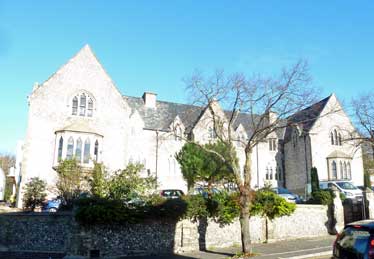Wakefield Road
After reading this page, try the Wakefield Road quiz
See also the Wakefield Road section on pages 64-67 of the proposed update for Round Hill's conservation character statement:
Wakefield Road runs almost parallel to Round Hill Crescent meeting Richmond Road at the top of the hill.
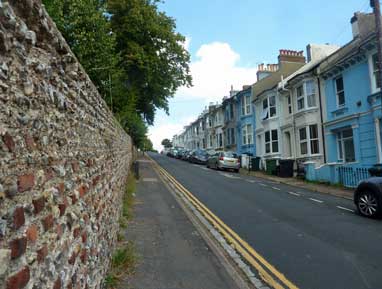
The tall brick and flint (‘bungaroosh’) wall along the west side, which dates from c1871, enclosed the former Wakefield Villa (later Woodfield Lodge), in nearly 3 acres of wooded land. Large mature trees behind and above the wall probably survive from the villa gardens.
A narrow stone staircase of six flights, a public right of way rising from Roundhill Crescent to Wakefield Road is now known as the Cats creep, formerly Lennox Road. Planned initially as a radial street extending from the Crescent, Lennox Road (mirroring D’Aubigny Road), the plan was eventually abandoned - possibly because the road was too steep for horse-drawn transport, with Wakefield Road and Ashdown Road developed as alternative routes.
Development of first properties in Wakefield Road are recorded in 1861. In 1875, the ‘Brighton Boys’ Brigade Home’ established in a large house of 1869 named ‘Bryn’ at the corner of Wakefield Road and Upper Lewes Road. By the 1880s, it was called the ‘Brighton Free Home for Destitute and Orphaned’.
Streetscape
The flint wall forms the boundary on the west side (with some mature trees and modern blocks of flats beyond). There is a slight curve at the end of an otherwise straight road, with more flint walling, at the junction with the Upper Lewes Road.
Early occupants of Wakefield Road lived on the west side where there were four houses. The 1871 census shows Katherine Tournot, annuit aged 59 living at no. 1, Richard Kennard, a County Court Clerk aged 49 living at no. 2, George Constable, a gardener living at no. 3 in the lower part of the street. Richard Edwards, a retired surveyor, lived with his niece and two servants at Wakefield Villa further up the street at no.4 Wakefield Road.
Although access to Wakefield Villa was from Wakefield Road, the villa itself was located in the apex land between Princes Crescent and Wakefield Road.
Numbers 1,2, & 3 were the cottages associated with Wakefield Villa, one of the Rose Hill Park villas. There are pictures of the villas in the James Gray Collection, the photographic archive of The Regency Society.
Rose Hill Park was developed by the Colbatch and the Clarke families in the late 1830s and the 1840s. It contained four detached mansions: Rose Hill Cottage ( also known as The Cottage and listed under Ditchling Road), Sylvan Lodge (known as Sylvan Hall from 1932 and listed under 1 Upper Lewes Road), Rosehill Villa (known as Hill Lodge by the 1900s and listed under Ditchling Road) and Wakefield Villa (at 4 Wakefield Road, also known as Woodfield lodge and then The Rookery).
Early in 1947, Brighton Corporation began a compulsory purchase of the 7.5 acre Sylvan Hall estate.As the old houses (including the cottages associated with them) were removed, blocks of two and three storey flats were erected, the first of these being occupied in 1951. Wakefield Villa (The Rookery) was demolished in 1951. It was no longer a family house. By 1931, it had been taken over by students and earlier it appears to have been used by trainee teachers from The C of E Diocesan Teachers Training College on the corner of Ditchling Road and Viaduct Road.
1-29 Wakefield Road (east side)
On the east side of Wakefield Road is a continuous terrace of two and three storey rendered houses with canted bays and pitched roofs facing the street, dating from the late 1870s.
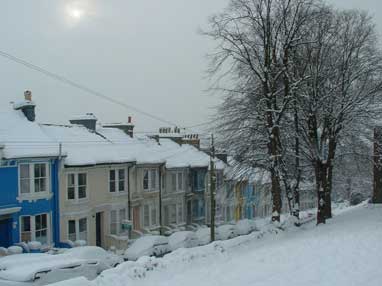
The terrace was re-numbered on 15th September 1880, sequentially beginning at number 2 towards the bottom of the road and ending at number 29 by the entrance to the Cat’s Creep.
Fern Villa is a large detached two-store cottage accessed via entrance steps and a passageway through 14 Wakefield Road and may date from c.1879.
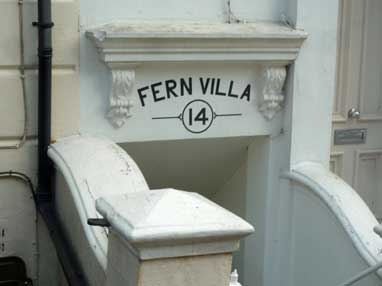

In 2011, planning application BH2011/03323 proposed the erection of a detached two-storey building which had the footprint of a house and was described as an earthship. It was argued that Fern Villa, a 1879 house which stands alone on land to the rear of Wakefield Road, constituted the beginning of a new building line.

Large numbers of residents again responded by vigorously opposing the proposal. There was even a dedicated Cats Creep Campaign website which pointed out the incongruity of placing a modern development right next to one of Round Hill's most valued Victorian buildings. It warned that starting a new building line next to Fern Villa would spell the end of protection of the only green open space we have in Round Hill. This space is totally within our conservation area and gets a special mention in the (2005) conservation area character statement. The value of long views into the Round Hill conservation area from public vantage points such as Race Hill and Tenantry Down was also emphasised. The application was refused in February 2012 by 10 votes to 2.
Almost all the houses in this sequentially numbered terrace (2-19 Wakefield Road) were built by the architect John Dallimore between 1877 and 1880, working together with Marshall, Scrase, Piper, Hayler, Child, Sattin, Wood and Stenning as well as on his own.
The exceptions were nos. 2 & 3, which were built by Stenning, and No. 23 which appears to have been built by Buster / Denman, although there is also permission on this site for 1 house and shop by Buster & Dallimore.
The 1891 population census shows that many of the occupations in this terrace were railway related. Residents included a ticket writer, a railway engine fireman, an engine fitter, a locomotive boiler maker, a hammerman, a coach painter , a steam engine maker, a goods guard, and a railway porter.
The census also showed 5 laundresses, 1 laundry packer and 1 ironer living in what was then a predominantly working class terrace.
Views
Looking south, there are good views of St Peter’s church, listed Grade II* (ref. 1380903)” and the sea.

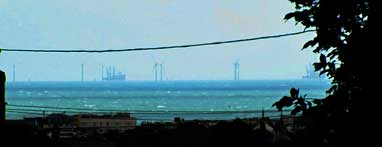
Shorter views, which have not proved popular with today’s residents, involve tagging and ugly forms of graffiti, which featured on the long wall running from Upper Lewes into Wakefield Road for many years.
In 2021, after collaboration involving the local residents’ association (The Round Hill Society), Brighton and Hove City Council and CityClean, funding was awarded allowing a group of artists to paint a design involving flora and fauna while sympathetically incorporating the existing ivy. The hope has been that this would reduce tagging and unsightly graffiti tagging.
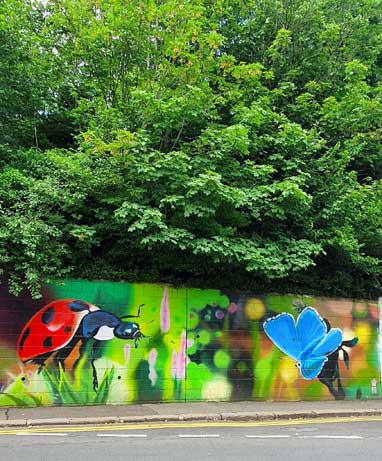
There have been setbacks along the way with ugly throw-ups being painted over artistic work, but these have quickly been cleaned off by local volunteers with money being raised by the community to buy anti-graffiti paint to protect against further damage.
The west side of Wakefield Road was continuously yellow-lined when the controlled parking zone was implemented on 1st July 2013. Pavement parking blocked the footway for many years up until then. The street now has less litter and is far more pedestrian friendly with its elegant long wall helping to frame views to the south.
Wakefield Road extra
Click on the bulleted links below if you would like to know
- who lived in the villas to the west of Wakefield Road in 1871.
Read also on this site:
A winter's scene in old Round Hill (or to be precise Rose Hill Park) by Chris Tullet. Then try this quiz.
OR
- when your home on the east side was being planned (many on the east side were planned in the late 1870s i.e. after the 1871 census.
House nos have changed since 1871 census
Records at THE KEEP (see foot of this page) show that numbers 2 and 3 on the west side of Wakefield Road were built in 1877.
The continuous terrace on the east side was re-numbered (sequentially beginning at No 2) on 15th September 1880.
Therefore the locations of numbers 1, 2 & 3 Wakefield Road recorded in the 1871 census do not relate to current numbers 1, 2 and 3 within the continuous terrace built later on the east side.
The occupants of the earlier numbers 1,2 & 3 on the west side include:
- No 1 Katherine A Tournot - Annuitant (aged 59) and two daughters (governesses in mid 30s)
- No 2 Richard Kennard - County Court Clerk (aged 49), wife (aged 52), mother (aged 76), also visiting Milliner (aged 29)
- No 3 George Constable - Gardener (aged 58); two daughers: laundress & dressmaker
Then comes
- No 4 Richard Edwards of Wakefield Villa
West Side (1871 census)
ROSE HILL PARK
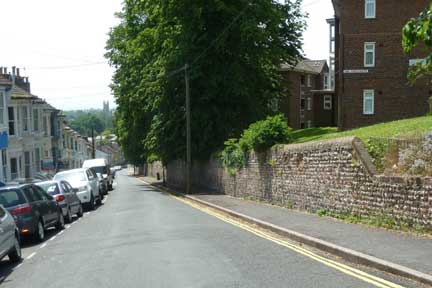
The Sylvan Hall Estate's own weblog records that the Colbatch Clark family bought the land in 1850. The northern section (Round Hill Park) also included semi-detached villas 68-80 east side of Ditchling Road.
Mapping the ROSE HILL PARK villas
"ROSE HILL" and "ROUND HILL" PARKS cover different areas -
Rose Hill Park, relating mainly to what is now Sylvan Hall, was bordered by Ditchling Road, Upper Lewes Road, Wakefield Road and most of the south side of Princes Crescent, covering a triangular area. The area north of what is now Bromley Road and round into Princes Crescent was due to be developed as The Round Hill Park
[ The ROUND HILL PARK villas are mapped on their own page ]
The side by side OS 25 inch 1892-1914 map is very useful for then and now locations, though it is not as good at naming them than the 1873-1875 map. With the latter, you will need to locate Round Hill by dragging the mouse, while swiping the mouse vertically to enlarge.

WAKEFIELD VILLA Richard Edwards (born in Hastings)
(later renamed Woodfield Lodge) was located at the end of Bromley Road in the apex land between Princes Crescent and Wakefield Road. On the west side of Wakefield Road, the driveway to Wakefied Villa is clearly visible on the 1897 side by side map as is the shorter section of drive leading to 31 & 32 Wakefield Road - the cottages associated with Wakefield Villa. The latter are located roughly opposite the current No 1 on the east side in the continuous terrace leading up to the Cats Creep at circa No 29.
Occupants of Wakefield Villa in 1871 include Richard Edwards (a Retired Surveyor (aged 72), his niece (aged 33), his housekeeper; two general servants (aged 16 and 14).
Both the Pages 1871 Street Directory and the The 1878 Street Directory (in which six houses are listed) identify 4 Wakefield Road as "Wakefield Villa". The James Gray Collection contains
- [1] a photograph of Wakefield Villa (1951)
taken just before its demoltion, by which time it had been re-named first Woodfield Lodge and then 'The Rookery".
Looking down the familar walled west side of Wakefield Road, the same collection shows
- [2] a photograph of 31 and 32 Wakefield Road (1963)
which had been cottages for the gardeners of Woodfield Lodge. Although these cottages are set back a little from the street, the caption claims that these were the only houses on the west side of Wakefield Road. Taken from another angle, the collection provides:
The Sylvan Hall weblog mentions that the present day building known as "The Laurels" was built on the site of 31, 32 and 33 Wakefield Road. Within the latter site, these cottages would have been further down Wakefield Road. The steps from Wakefield Road (west side) which form a back entrance to The Laurels (main access is via Bromley Road from Ditchling Road) are nearer to Wakefield Place than the apex of Princes Crescent and the top section of Wakefield Road.

ROSEHILL VILLA Thomas MOSELY (born London)
listing is under Ditchling Road
(known as Hill Lodge by the 1900s) south of Bromley Road and to the east of Ditchling Road. See 1951 picture.
In 1871 the head is an 80-year-old Clergyman with 33-year-old daughter and 31-year-old son working as a Barrister. There are four servants, all in their 50s - one a butler, one a lady’s maid, one a cook and one general domestic.

SYLVAN LODGE George L. CLOWSER (born Middlesex)
listing is under 1 Upper Lewes Road
(known as Sylvan Hall from 1923) a little set back from the junction of Upper Lewes Road and Wakefield Road and located at the end of Canterbury Drive on a site now occupied by flats called The Pines.
In 1871, the address of Sylvan Lodge is also given as 1 Upper Lewes Road. See | 1907 picture | 1976 picture | 1952 picture | viewed from driveway up from Upper Lewes Road.

ROSE HILL COTTAGE John Colbatch Onions (born Shrewsbury)
Listing is under Ditchling Road (The Cottage)
(also called "The Cottage"), a great deal larger than the name suggests, on the corner of Ditchling Road and Upper Lewes Road: in 1871, it housed 8 people: head of the household is 37-year-old Attorney John Colbatch Onions married to Sarah Jane Onions (also aged 37). There are four daughters and two sons, each bearing "Colbatch" as their middle name, as well as four domestic servants.
The history of Rose Hill Park
See full article by Chris Tullet on this site:
A winter's scene in old Round Hill (or to be precise Rose Hill Park)
Chris was one of the fourteen members of The Round Hill Local History Group who were key to the production of the book
ROSE HILL TO ROUNDHILL: a Brighton Community.
See Pages 17 to 20 information on Rose Hill including the memories of residents who had worked in the villas.
Chris Tullet's article mentions the Colbatch and Clark families, who developed Rose Hill Park in the 1840s, and records that the two families were to intermarry.
This is substantiated by the listing of "John Colbatch Clark" as living in Rose Hill Cottage on Page 2865 of the 1878 Post Office Directory, which also notes the Rev Thomas Moseley listed in the 1871 census as still the head occupant of Rose Hill Villa.
The Rev Thomas Mosley is already a widower in 1871 and would have reached the age of 87 by 1878.
Short Quiz
Questions which should be clarified after reading Chris Tullet's article are:
- Why are so many retired C of E clergymen living on the Sylvan Hall Estate in 1871?
- Who occupied Wakefield Villa (Woodfield Lodge) after it was renamed (a third time) "The Rookery" in 1931 before it was demolished in 1951?
- Where is "ROUND HILL PARK" in relation to "ROSE HILL PARK"? Which areas relate more to Wakefield Road and the top of Ditchling Road?
- What was a use of Rose Hill Villa important to women's employment opportunities at the beginning of the 20th century? Below is a picture clue.
DIOCESAN TRAINING COLLEGE Ditchling Rd & Viaduct Rd
Wakefield Road records at The Keep
I do not find a record of any plans for "a No. 1" within the continuous terrace being built on the east side.
A "No. 1" does appear in the 1891 street directory well after sequential renumbering in 1880.
1866 May Wakefield Road 1 house / Dallimore
1871 Wakefield Road Proposed retaining wall
1877 Sep 2 - 3 Wakefield Road 2 houses / Stenning
1877 July 4 Wakefield Road 1 house / Marshall / Dallimore
1877 June 5 - 6 Wakefield Road 2 houses / Scrase / Dallimore
1877 May 7 - 9 Wakefield Road 3 houses / Dallimore
1877 Aug 10 Wakefield Road and 11 Wakefield Road 2 houses / Piper / Dallimore
1878 May 10 Wakefield Road and 11 Wakefield Road Attics
1877 April 12 and 13 Wakefield Road 2 houses / Dallimore
1877 October Wakefield Road 1 house / Stenning
1878 May 12 Wakefield Road Attics
1878 April 16 Wakefield Road 1 house / Child / Dallimore
1878 May 16 Wakefield Road and 17 Wakefield Road Attics
1878 Feb 17 - 18 Wakefield Road 2 houses / Child / Dallimore
1878 Feb 19 - 20 Wakefield Road 2 houses / Sattin / Dallimore
1878 March 21 - 22 Wakefield Road 2 houses / Wood / Dallimore
1878 October 23 Wakefield Road 1 house and shop / Buster / Dallimore
1878 October 23 Wakefield Road 1 house / Buster / Denman
1879 March 24 - 29 Wakefield Road 6 houses / Stenning / Dallimore
1879 Apr Wakefield Road 1 house / Hayler / Dallimore - (Fern Villa?)
1880 Sep Re-numbering of Wakefield Road
1891 February 24 Wakefield Road Scullery
1929 Sep 14 Wakefield Road (now Fern Villa) photo of Marion Reeve
1936 Dec to 1968 April Purchase of Sylvan Hall, Hill Lodge, Woodfield Lodge, cottages in Wakefield Road and Chichester Diocesan College, Ditchling Road
Wakefield Road in the 1890s
Click here to scroll to an alphabetical list of all the occupations.
Practise using the Census data site e.g. study of Wakefield Road
- At http://www.freecen.org.uk complete these fields ONLY:
- Surname: Pelling
- First name: Edgar
- Census County: Sussex
- Census Place: Brighton
- Census Year: 1891
- Click the SEARCH button
- Select for all the information
- Continue viewing data for more households in the same street (or one nearby) by clicking the or buttons
You will gather data on everybody living in Wakefield Road in 1891, including servants.
A known resident is Edgar PELLING of 19 Wakefield Rd (born in Sussex)
Another is Charles COX-DAVIS of 15 Wakefield Rd (born in Somerset)
Another is James VIGAR of 4 Wakefield Rd (born in Sussex).
The lets you fill in the street name. Take care to shorten "Wakefield Road" to "Wakefield Rd" . The birth county is optional.
Occupations (1891)
There was even a Tricycle Maker living at 19 Wakefield Road very near to where "Dr Bike" lives now.
Click on the housenumber to find the names and family relationships:
1 to 7
Undertakers Bearer, Ticket Writer, Plumber, Blind Makers Assistant, Scholar, Housekeeper, Laundress, Drapers Assistant, Dressmaker, Ironer, Scholars (3), Coachsmith, Scholar, Greengrocer, Goods Guard Station, Railway Engine Fireman, Laundry Packer, Fitters Labourer, Milliner, Widow, Scholars (3), Butcher, Gasfitters Apprentice, Scholars (3), Coal Porter, Laundress, Scholars (3), General Domestic Servant.
8 to 15
Bricklayer, Watchmakers Apprentice, Wood Turner, Cashier in Ironmongers, Scholar, Mechanical Engineer, Scholar, Widow, Cert School Mistress (2), Clerk Sussex Daily News (2), Dressmaker, Newspaper Publisher, Candidate Pupil Teacher, Heraldic Decorative Painter, Dressmaker (2), Engine Fitter, Scholar, Carpenter, Scholars (2), Draper’s Porter, Grocer’s Manager, General Domestic Servant, Lodging House Keeper, Private Means.
15 to 20
Chemists and Druggists Manager, Dressmaker, Private Means, Painter, Mantle Maker, Private Means, Dressmaker, Private Income, General Servant, Shoemaker, Tailoress (2), Butler, Gasfitter, Wheelwright, Scholars (3), Tricycle Maker, Dressmaker, Scholar, Printers Compositor, Laundress (2), Basket Maker, Scholars (4)
21 to 27
Dressmaker, Laundress, Traveller Wines / Spirits, Drapers Apprentice, Brewers Clerk, Auctioneers Clerk, Post Office Clerk, Scholars (3), Schoolmistress, Scholars (2), Spring Maker, Steam Engine Maker, Scholars (2), Locomotive Boiler Maker, Dressmaker, Coach Painter, Scholars (3)
28 -34 & 35
Railway Porter, Scholar, Hammerman Railway, Schoolmaster, Tailor, Scholars (2), Milliner, Musical Instrument Dealer, General Servant, Upholsterer, House Painter, Dressmaker, retired couple both aged 78, Coachman, Scholars (2)
Occupations A-Z
Auctioneers Clerk
Basket Maker
Blind Makers Assistant
Brewers Clerk
Bricklayer
Butcher
Butler
Candidate Pupil Teacher
Carpenter
Cashier in Ironmongers
Cert School Mistress (2)
Chemists and Druggists Manager
Clerk Sussex Daily News (2)
Coachman
Coach Painter
Coachsmith
Coal Porter
Drapers Apprentice
Drapers Assistant
Draper’s Porter
Dressmaker (10)
Engine Fitter
Fitters Labourer
Gasfitter
Gasfitters Apprentice
General Domestic Servant (4)
Goods Guard Station
Greengrocer
Grocer’s Manager
Hammerman Railway
Heraldic Decorative Painter
Housekeeper
House Painter
Ironer
Laundress (5)
Laundry Packer
Locomotive Boiler Maker
Lodging House Keeper
Mantle Maker
Mechanical Engineer
Milliner (2)
Musical Instrument Dealer
Newspaper Publisher
Painter
Plumber
Post Office Clerk
Printers Compositor
Private Means or Income (4)
Railway Engine Fireman
Railway Porter
retired couple both aged 78
Scholars (42)
Schoolmaster
Schoolmistress
Shoemaker
Spring Maker
Steam Engine Maker
Tailor
Tailoress (2)
Ticket Writer
Traveller Wines / Spirits
Tricycle Maker
Undertakers Bearer
Upholsterer
Watchmakers Apprentice
Wheelwright
Widows (2)
Wood Turner
Round Hill history texts
Ashdown Road | Belton Road | Crescent Road | D'Aubigny Road | Ditchling Road | Lennox Passage (The Cats Creep) | Mayo Road | Princes Crescent | Princes Road | Richmond Road | Round Hill Crescent | Round Hill Road | Round Hill Street | Wakefield Road
